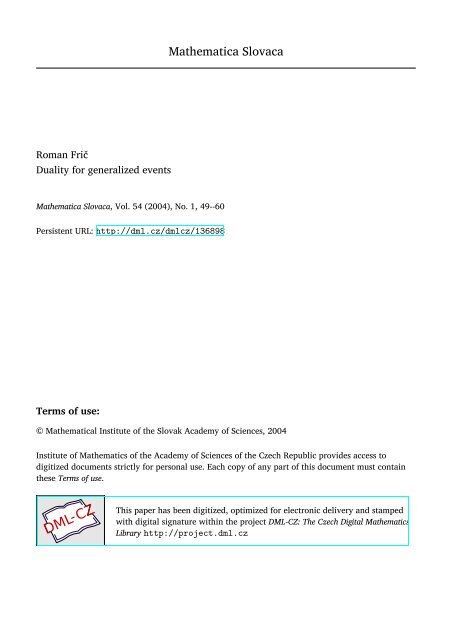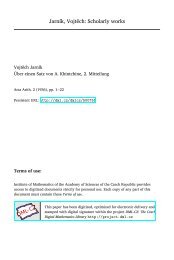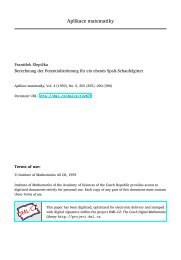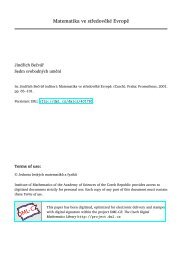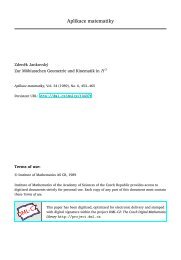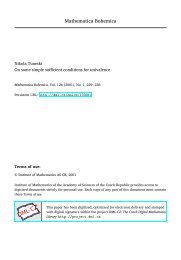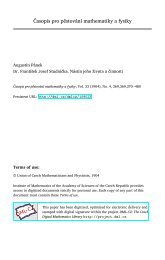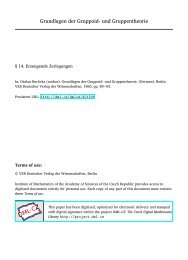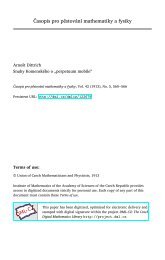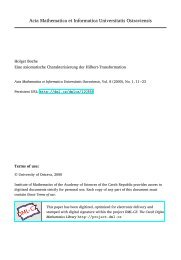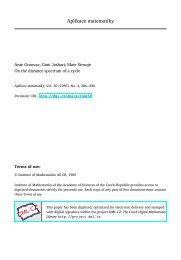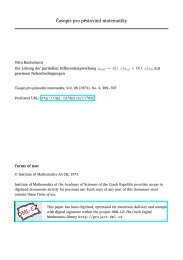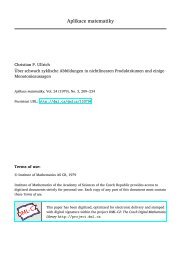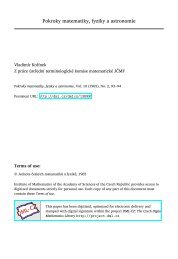Duality for generalized events
Duality for generalized events
Duality for generalized events
You also want an ePaper? Increase the reach of your titles
YUMPU automatically turns print PDFs into web optimized ePapers that Google loves.
Roman Frič<br />
<strong>Duality</strong> <strong>for</strong> <strong>generalized</strong> <strong>events</strong><br />
Mathematica Slovaca, Vol. 54 (2004), No. 1, 49--60<br />
Persistent URL: http://dml.cz/dmlcz/136898<br />
Terms of use:<br />
Mathematica Slovaca<br />
© Mathematical Institute of the Slovak Academy of Sciences, 2004<br />
Institute of Mathematics of the Academy of Sciences of the Czech Republic provides access to<br />
digitized documents strictly <strong>for</strong> personal use. Each copy of any part of this document must contain<br />
these Terms of use.<br />
This paper has been digitized, optimized <strong>for</strong> electronic delivery and stamped<br />
with digital signature within the project DML-CZ: The Czech Digital Mathematics<br />
Library http://project.dml.cz
Mathematica<br />
Slovaca<br />
©2004<br />
.. , -., _. /rirk n A \ .. .. Ar , c ~ Mathematical Institute<br />
Math. SlOVaCa, 54 (2004), No. 1, 49-60 Slovák Academy of Sciences<br />
Dedicated to Professor Sylvia Pulmannovd<br />
on the occasion of her 65th birthday<br />
DUALITY FOR GENERALIZED EVENTS<br />
ROMAN FRIC<br />
(Communicated by Anatolij Dvurečenskij )<br />
ABSTRACT. We study the category of effect algebras (equivalently D-posets)<br />
carrying the initial sequential convergence with respect to a set of order determining<br />
probabilities. We define distinguished subcategories and describe their mutual<br />
relationships. In particular, we deal with duality, products, and coproducts. Such<br />
structures are suitable <strong>for</strong> modelling <strong>events</strong> having fuzzy and quantum nature.<br />
0. Introduction<br />
Undoubtedly ([3], [19], [4], [5], [6], [15], [29], [30], [16]), D-posets and effect<br />
algebras are suitable structures in the framework of which the <strong>generalized</strong> probability<br />
can be developed. We continue (cf. [7], [8], [9], [10], [11], [12], [13], [14])<br />
in our ef<strong>for</strong>t to study <strong>generalized</strong> probability using sequential convergence and<br />
categorical methods.<br />
Given a category, hom(X, Y) denotes the set of all morphisms from the object<br />
X into the object Y; it will be clear from the context which category hom(X, Y)<br />
refers to.<br />
2000 Mathematics Subject Classification: Primary 22A30, 54A20, 60A05; Secondary<br />
06A55, 08A72, 54C20.<br />
Keywords: D-poset, effect algebra, convergence D-poset, convergence effect algebra, order<br />
determining set of D-poset morphisms, I-convergence, sequentially continuous D-poset morphism,<br />
prob, probability, epireflection, cr-completion, absolute prob, sober prob, measurable<br />
space, measurable map, natural equivalence, duality, product, coproduct, operational random<br />
variable, <strong>generalized</strong>: event, random variable, observable.<br />
Supported by VEGA Grant 2/3163/23.<br />
49
ROMAN FRlC<br />
1. Convergence<br />
There is an extensive list of papers devoted to sequential convergence on<br />
various algebraic structures. Interesting results about sequential convergence on<br />
MF-algebras can be found in [17].<br />
By a sequential convergence on a set X we understand a subset L C X N x X<br />
satisfying the following conditions:<br />
(S) If (xn) is a constant sequence and xn = x, n G N, then ((xn),x) G L.<br />
(F) If ((xn),x) G L and (x'n) is a subsequence of (xn), then ((x'n),x) G L.<br />
In addition, we mention the following conditions:<br />
(H) If ((xn),x) G L and ((xn),y) G L, then x = y<br />
(the uniqueness of limits).<br />
(U) If (xn) is a sequence and x G X is a point such that <strong>for</strong> each subsequence<br />
(x'n) of (xn) there exists a subsequence (x'n) of (xn) such that<br />
((x'n),x) G L, then ((xn),x) G L (Frechet-Urysohn condition).<br />
(B) If ((an),x), ((bn),x) G L and an < xn < bn, n G N, then ((xn),x) G L.<br />
Let X = (\X\,
DUALITY FOR GENERALIZED EVENTS<br />
1.1. DEFINITION. Let X be an effect algebra and let L C X N x X be a<br />
sequential convergence on X such that<br />
(EC) If ((xn),x) G L, ((yn),y) G L and yn 0 xn exists <strong>for</strong> all n G N, then<br />
y 0 x exists and ((xn 0 yn), x 0 y) G L.<br />
Then X carrying L is said to be a convergence effect algebra.<br />
It is known (cf. [4; Theorem 1.3.4]) that the category of D-posets and<br />
K)-poset morphisms and the category of effect algebras and effect algebra morphisms<br />
are equivalent. The result can be <strong>generalized</strong> as follows.<br />
Denote CD the category whose objects are convergence F)-posets and whose<br />
morphisms are sequentially continuous D-poset morphisms. Denote CE the<br />
category whose objects are convergence effect algebras and whose morphisms<br />
are sequentially continuous effect algebra morphisms. Since each D-poset can<br />
be considered as a convergence D-poset carrying the trivial convergence (only<br />
constant sequences converge) and each D-poset morphism is sequentially continuous<br />
with respect to the trivial convergence, K)-posets (as trivial convergence<br />
D-posets) <strong>for</strong>m a full subcategory of CD. Similarly, effect algebras (as trivial<br />
convergence effect algebras) <strong>for</strong>m a full subcategory of CE .<br />
Let (X, CE and<br />
F2: CE —> CD , the compositions of which are the identity functors on CD<br />
and CE. Hence the two categories are isomorphic and isomorphic are also the<br />
subcategories consisting of objects carrying the trivial convergence.<br />
In what follows, J denotes the closed unit interval of real numbers carrying<br />
the usual algebraic (also the D-poset and the effect algebra) structures and the<br />
sequential convergence.<br />
1.2. OBSERVATION. The categories CD and CE are isomorphic.<br />
Now let us turn to the initial convergence with respect to sets of morphisms<br />
into I (in fact, probability measures). In view of the isomorphism between<br />
D-posets and effect algebras, in what follows we assume that the partial operations<br />
0 and 0 on a set X are dual, the partial order and the constants 0,<br />
1 are compatible with 0 and 0.<br />
51
ROMAN FRlC<br />
Let X be a D-poset. A subset H C hom(X, I) is said to be order determining<br />
(cf. [5]), or an ordering (cf. [4]), whenever h(b) < h(a) in I <strong>for</strong> all h G H<br />
implies b < a in X. Denote Ods(X) the set of all order determining subsets<br />
of hom(K,i~). Assume that hom(X,J) G Ods(K) (equivalently, Ods(X) ^ 0).<br />
For eaclr H G Ods(X) define the evaluation map evH: X —•> I H by evH(x) =<br />
(h(x)\ he H), x e X.Let \ evH(X)\ = {ev^(x) : x G X). The following is a<br />
folklore.<br />
1.3. LEMMA. evH(X) is a sub-D-poset of the power D-poset I H and X and<br />
evH(X) are isomorphic.<br />
Further, define LH C X N x X as follows: ((xn),x) G hH whenever <strong>for</strong> each<br />
h G H the sequence (h(xn)) converges in I to h(x).<br />
1.4. LEMMA. hH is a sequential convergence on X satisfying the axioms<br />
(DC), (EC), (H), (U), (B).<br />
Proof. If we identify X and evH(X), then hH becomes the pointwise<br />
convergence in I H restricted to evH(X). A straight<strong>for</strong>ward calculation shows<br />
that the axioms in question are satisfied. D<br />
For H,G G Ods(X), H C G implies LG C LH and \om(xj)<br />
ls the finest of<br />
all convergences hH, H G Ods(X). For H,G G Ods(X) define H ~ G whenever<br />
L^ = LG . It is an equivalence relation and each equivalence class [H] contains<br />
the maximal element H* — \J G. Denote hom^(X,/) = {h G hom(X, I) :<br />
Ge[H]<br />
h is sequentially continuous with respect to L^}. Then H* = hom//(X,I).<br />
Clearly, homhom(x/)(X,7) =hom(X,7).<br />
1.5. DEFINITION. Let X be a F>-poset and let H G Ods(X). Then LH is<br />
said to be an I-convergence. If H = hom(X, 7), then hH is said to be the fine<br />
convergence.<br />
Sub-D-posets of the power D-posets I H carrying the pointwise convergence,<br />
called jD(/)-posets, have been studied in [25]. In Section 3 we shall show that<br />
such D-posets and D-posets carrying /-convergences are naturally equivalent.<br />
Since D-posets and effect algebras are equivalent we propose a simple compromising<br />
terminology.<br />
The idea is similar as in topology where, in fact, we have four isomorphic<br />
structures defined via open sets, closed sets, a closure operator, neighborhoods.<br />
To define a topological space, we can start with any of the four (e.g. open sets)<br />
and then to define any of the remaining (e.g. neighborhoods of points), so that<br />
going back (defining an open set as a set containing a neighborhood of each of its<br />
points) we get the original one (open sets). Further, the morphisms defined via<br />
the preimages of the open or closed sets, via preserving the closure (if a point is<br />
52
DUALITY FOR GENERALIZED EVENTS<br />
in the closure of a set, then the image of the point is in the closure of the image of<br />
the set), or via the continuity at each point (using the neighbourhoods), yield the<br />
identical notion of a continuous map. And, instead of four different isomorphic<br />
categories (of open or closed sets spaces, closure spaces, neighborhood spaces),<br />
we work with topological spaces and continuous maps.<br />
1.6. DEFINITION. Let (X,
ROMAN FRlC<br />
sequential closedness. In this section we generalize such extension process to<br />
probs. The idea of the construction goes back to [23], [24].<br />
2.1. DEFINITION. Let E be a prob. If £ is a subprob of a prob E and<br />
each morphism from E into / can be extended to a morphism from E into I,<br />
then E is said to be I -embedded in E. Moreover, if each extension is uniquely<br />
determined, then E is said to be hom-dense in E. If E is sequentially closed in<br />
each prob in which it is /-embedded, then E is said to be absolutely sequentially<br />
closed, or simply absolute.<br />
Denote APB the full subcategory of PB consisting of all absolute probs.<br />
2.2. LEMMA. Let E be a prob. The following are equivalent:<br />
(i) E is absolute.<br />
(ii) In E the following implication holds true: if a sequence (xn) of elements<br />
of E does not converge in E, then there exists (p G hom(E: I) such that<br />
the sequence (p(xn)) does not converge in I.<br />
Proof.<br />
(i) implies (ii). Since E is a prob, the evaluation map ev is an isomorphism<br />
from E onto a subprob of / hom (^J). If we identify E with its image ev(E),<br />
then E becomes an /-embedded subprob of J hom (£>1). Assume (i) and let (xn)<br />
be a sequence in E which does not converge in E. Contrariwise, suppose that<br />
<strong>for</strong> each (p G hom(F7,1) the sequence (cp(xn)) converges in I. The sequence<br />
(ev(sn)) converges in J hom (£>1) and it follows from (i) that the limit belongs to<br />
ev(E). This is a contradiction.<br />
(ii) implies (i). Assume (ii). Contrariwise, suppose that (i) does not hold.<br />
Then E can be /-embedded in a prob E such that there exists a sequence (xn)<br />
of elements of E converging in £ to a point x G E\E. According to (ii) there<br />
exists (p G hom(j5, /) such that the sequence (
DUALITY FOR GENERALIZED EVENTS<br />
2.4. THEOREM. APB is an epireflective subcategory of PB .<br />
Proof. Let E be a prob. First, we shall construct a prob E such that:<br />
(el) There is no proper subprob F of E such that \E\ C |F| and |F| is<br />
sequentially closed in E;<br />
(e2) E is /-embedded in E\<br />
(e3) E is absolute.<br />
Second, we shall prove that the embedding of E into E is the desired epireflection:<br />
1. For each morphism cp from E into an absolute prob F there exists a<br />
unique morphism Tp from E into F such that the restriction of Tp to E<br />
is equal to (p, in symbols Tpj E = (p.<br />
2. The embedding of E into E is an epimorphism. Hence passing from E<br />
to E yields the desired epireflector.<br />
1. Consider the evaluation mapping ev from E into J hom (£J) defined by<br />
ev(x) = ((#);
ROMAN FRlC<br />
Denote a the epireflector from PB onto APB assigning to a prob E the<br />
prob E = a(E) and to each morphism -0 from a prob E into a prob F the<br />
unique morphism a(ip) from a(E) into a(F) defined as follows: let ip be the<br />
composition of ip and the embedding map from F into a(F), let Tp be the<br />
unique extension of 3^, defined by f < (u) = u o / is a sequentially continuous<br />
D-poset morphism. Denote MH? the category of ID-measurable spaces and<br />
ID -measurable maps. Denote SMID its subcategory consisting of sober spaces.<br />
56
DUALITY FOR GENERALIZED EVENTS<br />
If (X, X) is a sober space, then <strong>for</strong> each sequentially continuous D-poset morphism<br />
h of X into y there exists an (X, y) -measurable map / such that<br />
h = f«. This is the essence of the duality between ID and SMID ([25; Theorem<br />
1.12]).<br />
The duality can be extended to probs. Indeed, the duality means that there<br />
exist a natural equivalence functor F: PB -» SMID op , where the target category<br />
SMID op is the opposite category associated to SMID (the same objects<br />
but the direction of the arrows is reversed). It is known that SID and SMID op<br />
are isomorphic ([25; Theorem 1.11]). Hence to show that PB and SMID are<br />
dual, it suffices to construct a natural equivalence functor G: PB -» SID .<br />
Let X be a D-poset admitting an order determining set H £ hom(X, 7),<br />
let hH be the corresponding /-convergence, and let H* = hom//(X,I). Consider<br />
the resulting prob (X, SID , the functor is full and<br />
faithful, and each object of SID is isomorphic to the evaluation of some prob<br />
(cf. [20; Theorem IV.4.1]). But this is obvious.<br />
COROLLARY 3.1. The categories PB and SMID are dual.<br />
Further, reorganizing each ID -object X C I x into a prob, we get the category<br />
MPB of PB -measurable spaces and its subcategory SMPB of sober<br />
objects.<br />
COROLLARY 3.2. The categories PB and SMPB are dual.<br />
An ID-measurable space (X,X) is said to be closed if X is sequentially<br />
closed in I x . The subcategory CMID of MID consisting of closed<br />
ID-measurable spaces is monocoreflective in MID (cf. [25]). Accordingly, we<br />
say that a prob X and the PB -measurable space (X, X) are closed whenever<br />
X as an ID -object is closed. It follows that the subcategory CMPB of<br />
closed PB -measurable spaces is monocoreflective in the category MPB . For a<br />
PB -measurable space (X, X) denote (X, cr(X)) the monocoreflection. If (X, X)<br />
is sober, then (X, cr(X)) is sober, too.<br />
COROLLARY 3.3. The duality between PB and SMPB commutes with the<br />
epireflector sending a prob X to the absolute prob O~(X) and the monocoreflector<br />
sending the sober PB -measurable space (H, %), where H = hom(X, I) and<br />
T-L is the image of X under the evaluation map (via H), to the closed sober<br />
PB-measurable space (il, O-('H)). If X is absolute, then % is closed.<br />
Observe that a 2-chain {0, a, 1} admits an order determining family, but<br />
the diamond {0, a, b, 1} as the coproduct in the category of D-posets of two<br />
57
ROMAN FRICZ<br />
2-chains does not admit any order determining family. M. Papco, at the<br />
SCAM-conference in Bratislava, April 2003 (cf. [25]), presented the construction<br />
of the product of ID -measurable spaces leading to the construction of the<br />
coproduct in the category ID . The latter yields the coproduct in the category<br />
PB.<br />
Let {Xs : s G 5} be a family of probs. Denote Hs = hom(X3,I) and,<br />
as a rule, identify Xs and its image evs(X3) C I Hs under the evaluation map<br />
evs: Xs -> I H *. Consider the product H = Y\ Hs and the prob I H . For t G S,<br />
s£S<br />
define a natural embedding nt of evt(Xt) = Xt into I H , sending u G Xt C I Ht<br />
to ut G I H defined as follows: <strong>for</strong> h = (h3; s G S) G H put ut(h) = u(ht), i.e.<br />
i/t depends only on the tth coordinate. It is a sequentially continuous D-poset<br />
morphism of Xt into I H . Let X C I H he the minimal subprob of I H which<br />
contains KS(XS), S G 5. If all involved probs are considered as ID objects<br />
and all PB morphisms are considered as ID morphisms, then (as shown by<br />
M. Papco) X, together with the coprojections {KS : Xs -» X : s G S}, is the<br />
coproduct of the family {Xs : s G 5} in ID .<br />
THEOREM 3.4. Let {Xs : s G S} be a family of probs. Then X, together<br />
with the coprojections {KS : Xs —> X : s G 5}, is the coproduct of the family<br />
{Xs: se S} in PB .<br />
Proof. The assertion follows directly from the definition of a coprodut and<br />
the fact that each prob and its image under the evaluation (via the set of all<br />
morphisms) are isomorphic. •<br />
4. Remarks<br />
The categories PB and MPB provide a tool <strong>for</strong> studying <strong>generalized</strong> probability:<br />
<strong>events</strong>, measures, random variables, observables. In [1], [2] (see also [15])<br />
the operational random variable is defined as a suitable map of the set of all probability<br />
measures on one measurable space into the set of all probability measures<br />
on another measurable space. If the map sends a point measure (an elementary<br />
event) to a nontrivial probability measure, then the random variable has a quantum<br />
nature. We claim that ID -measurable maps, and hence PB -measurable<br />
maps, generalize the operational random variables. Further, the duality between<br />
PB and SMPB covers the duality between operational random variables and<br />
the observables (going the opposite direction) as it is described in [1], [2]. We<br />
also claim that the sequential convergence and the categorical approach shed<br />
more light on the duality between the operational random variables and the<br />
observables.<br />
58
DUALITY FOR GENERALIZED EVENTS<br />
As already stated in [25], in order to develop further probability notions,<br />
it might be useful to introduce and study on D-posets and hence on probs a<br />
multiplication operation (cf. [21], [22], [18], [27], [28]).<br />
REFERENCES<br />
BUGAJSKI, S.: Statistical maps I. Basic properties, Math. Slovaca 51 (2001), 321-342.<br />
BUGAJSKI, S.: Statistical maps II. Operational random variables, Math. Slovaca 51<br />
(2001), 343-361.<br />
CHOVANEC, F.—KÔPKA, F.: Difference posets in the quantum structures background,<br />
Internat. J. Theoret. Phys. 39 (2000), 571-583.<br />
DVUREČENSKIJ, A.—PULMANNOVÁ, S.: New Trends in Quantum Structures,<br />
Kluwer Academic Publ./Ister Science, Dordrecht/Bratislava, 2000.<br />
FOULIS, D. J.: Algebraic measure theory, Atti. Sem. Mat. Fis. Univ. Modena 48 (2000),<br />
435-461.<br />
FOULIS, D. J.—BENNETT, M. K.: Effect algebras and unsharp quantum logics, Found.<br />
Phys. 24 (1994), 1331-1352.<br />
FRIC, R.: Sequential structures and probability: categorical reflections. In: Mathematik-Arbeitspapiere<br />
48 (H.-E. Porst, ed.), Universität Bremen, 1997, pp. 157-169.<br />
FRIC, R.: A Stone type duality and its applications to probability, Topology Proc. 22<br />
(1999), 125-137.<br />
FRIČ, R.: On observables, Internat. J. Theoret. Phys. 39 (2000), 677-686.<br />
FRIČ, R.: MV-Algebras: convergence and duality. In: Mathematik-Arbeitspapiere 54<br />
(H. Herrlich, H.-E. Porst, eds.), Universität Bremen, 2000, pp. 169-179.<br />
FRIČ, R.: Convergence and duality, Appl. Categ. Structures. 10 (2002), 257-266.<br />
FRIČ, R.: Measures on MV-algebras, Soft Comput. 7 (2002), 130-137.<br />
FRIC, R.: Łukasiewicz tribes are absolutely sequentially closed bold algebras, Czechoslovak<br />
Math. J. 52 (2002), 861-874.<br />
FRIC, R.—JAKUBÍK, J.: Sequential convergences on Boolean algebras defined by systems<br />
of maximal filters, Czechoslovak Math. J. 51 (2001), 261-274.<br />
GUDDER, S.: Combinations of observables, Internat. J. Theoret. Phys. 31 (2000),<br />
695-704.<br />
JENČA, G.: Blocks of homogeneous effect algebras, Bull. Austral. Math. Soc. 64 (2001),<br />
81-98.<br />
JAKUBÍK, J.: Sequential convergence in MV-algebras, Czechoslovak. Math. J. 45,<br />
(1995), 709-726.<br />
JUREČKOVÁ, M.: On the conditional expectation on probability MV-algebras with product,<br />
Soft Comput. 5 (2001), 381-385..<br />
KÔPKA, F.—CHOVANEC, F.: D-posets, Math. Slovaca 44 (1994), 21-34.<br />
MAC LANE, S.: Categories <strong>for</strong> the Working Mathematician, Springer-Verlag, New<br />
York-Heildelberg-Berlin, 1988.<br />
MUNDICI, D.: Tensor products and the Loomis-Sikorski theorem <strong>for</strong> MV-algebras, Adv.<br />
in Appl. Math. 22 (1999), 227-248.<br />
MUNDICI, D.—RIEČAN, B.: Probability on MV-algebras. In: Handbook of Measure<br />
Theory (E. Pap, ed.), North-Holland, Amsterdam, 2002.<br />
59
ROMAN FRl£<br />
[23] NOVAK, J. : Uber die eindeutigen stetigen Erweiterungen stetiger Funktionen, Czechoslovak<br />
Math. J. 8 (1958), 344-355.<br />
[24] NOVAK, J.: On sequential envelopes defined by means of certain classes of functions,<br />
Czechoslovak Math. J. 18 (1968), 450-456.<br />
[25] PAPCO, M.: On measurable spaces and measurable maps, Tatra Mt. Math. Publ.<br />
(To appear).<br />
[26] PAPCO, M.: On effect algebras. Preprint, 2003.<br />
[27] PETROVICOVA, J.: On the entropy of partitions in product MV-algebras, Soft Comput.<br />
4 (2000), 41-44.<br />
[28] PETROVICOVA, J.: On the entropy of dynamical systems in product MV-algebras,<br />
Fuzzy Sets and Systems 121 (2001), 347-351.<br />
[29] RIECAN, B.—NEUBRUNN, T.: Integral, Measure, and Ordering, Kluwer Acad. PubL,<br />
Dordrecht-Boston-London, 1997.<br />
[30] RIECANOVA, Z.: Proper effect algebras admitting no states, Internat. J. Theoret. Phys.<br />
40 (2001), 1683-1691.<br />
Received Apríl 11, 2003 Mathematical Institute<br />
Slovák Academy of Sciences<br />
Grešákova 6<br />
SK-040 01 Košice<br />
SLOVAKIA<br />
60<br />
E-mail: fric@saske.sk


